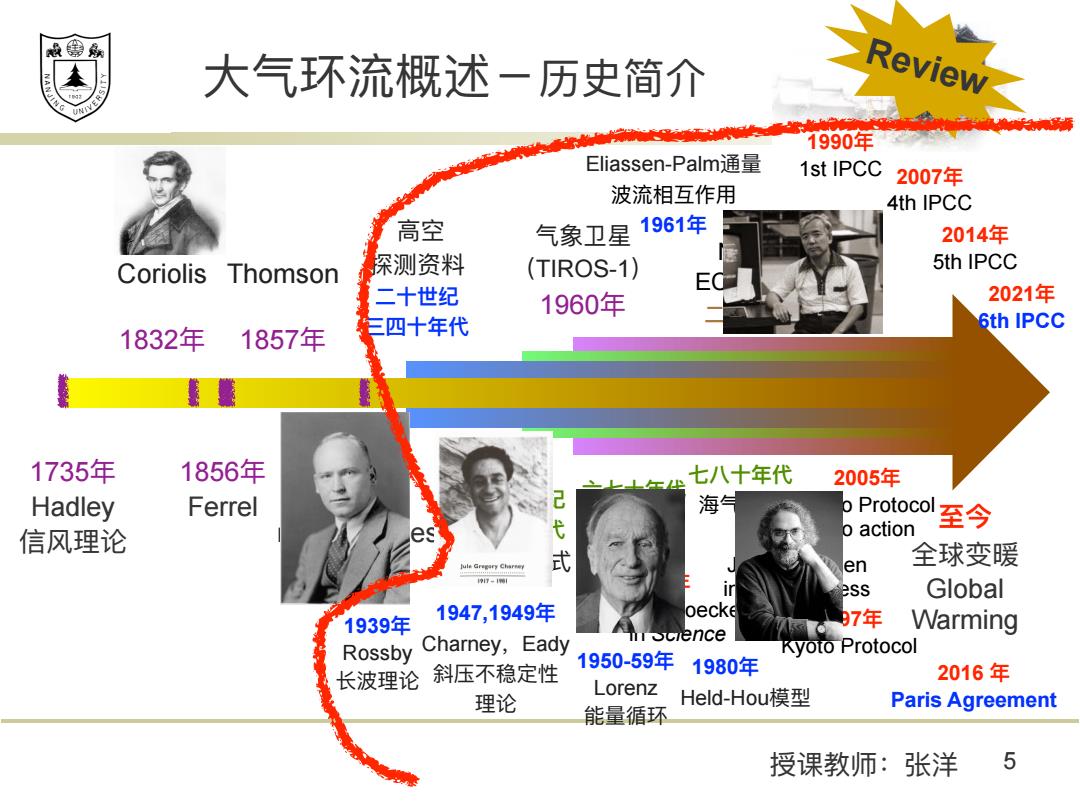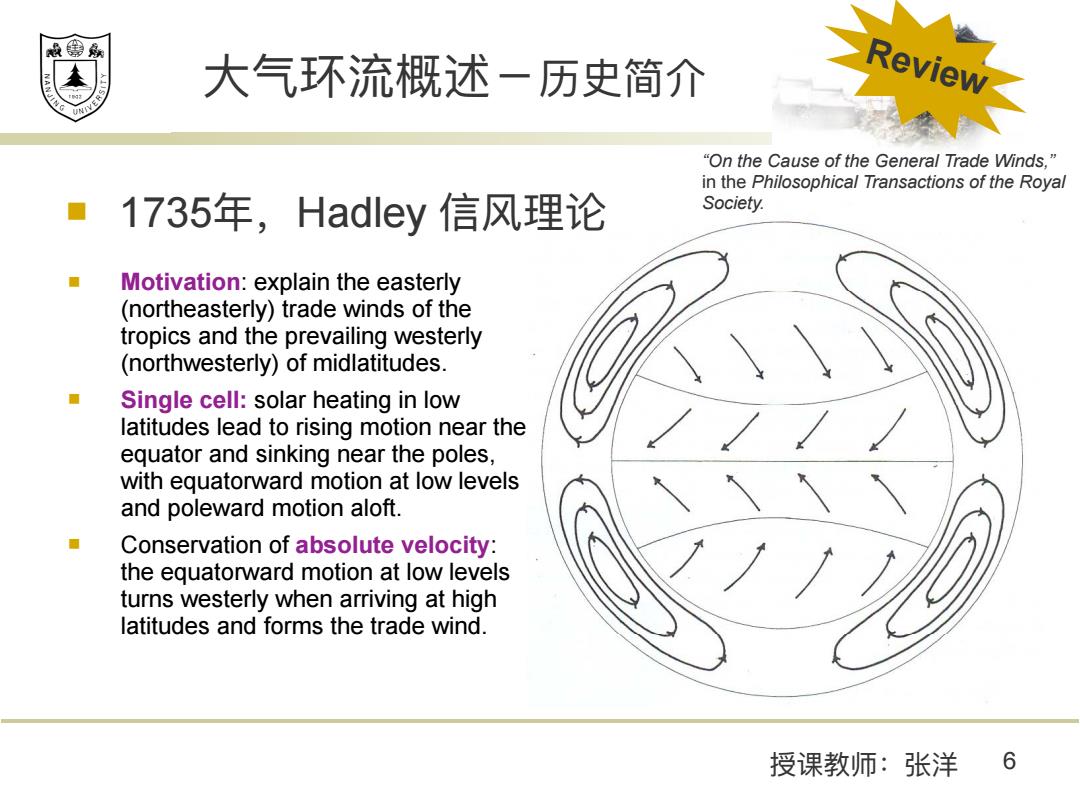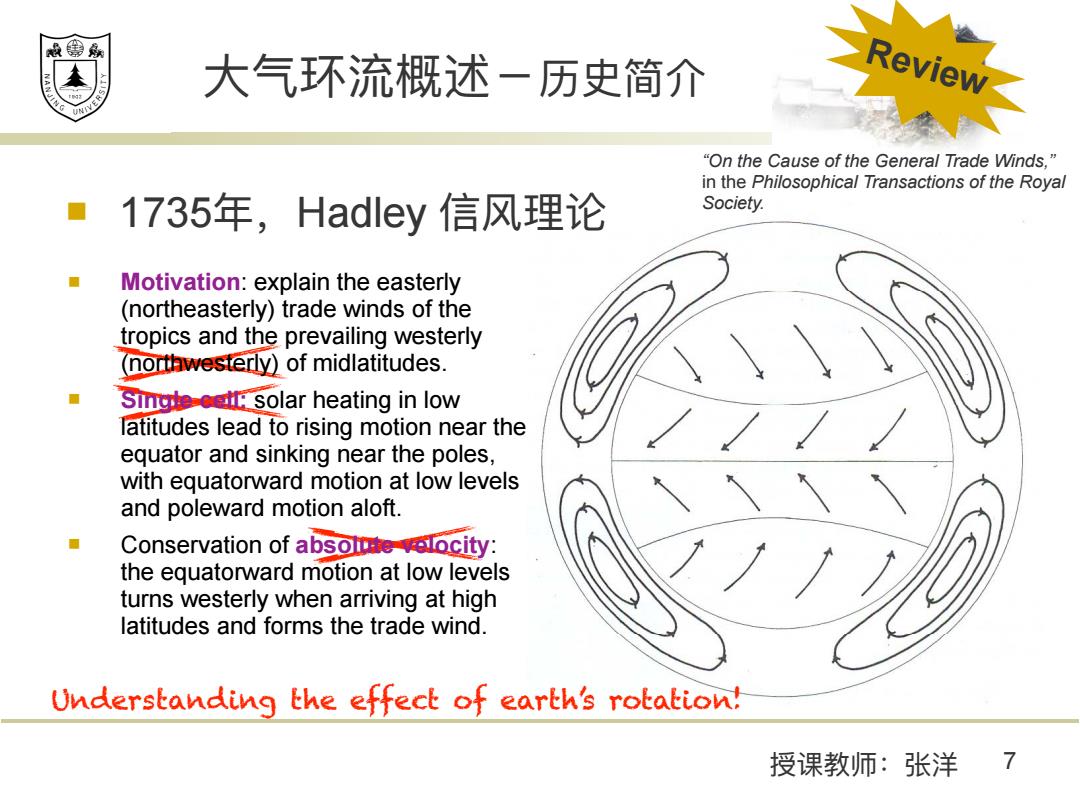
设 大气环流概述 UNN ■历史回顾 ■内容简介 观测资料 资料处理与分析 ·再分析资料 ■分析方法 授课教师:张洋3
大气环流概述 ! 历史回顾 ! 内容简介 ! 观测资料 ! 资料处理与分析 ! 再分析资料 ! 分析方法 授课教师:张洋 3

&售 大气环流概述一历史简介 Review 1990年 Eliassen-Palm通量 1st IPCC 2007年 波流相互作用 4th IPCC 高空 气象卫星 1961年 2014年 NCEP/NCAR Coriolis Thomson 探测资料 (TIROS-1) 5th IPCC ECMWF,再分析 二十世纪 1960年 2021年 三四十年代 二十世纪九十年代 6th IPCC 1832年 1857年 1735年 1856年 二十世纪 七八十年代 2005年 Hadley Ferrel 前二三十年 二十世纪 六七十年代 气候模式 海气模式Kyoto Protocol 五十年代 into action 至今 信风理论 role of eddies 1988年 数值模式 James Hansen 全球变暖 1975年 in US Congress Global 1947,1949年 Wally Broecker 1939年 1997年 Warming Rossby Charney,Eady in Science Kyoto Protocol 长波理论 斜压不稳定性 1950-59年 1980年 2016年 理论 Lorenz Held-Hou模型 Paris Agreement 能量循环 授课教师:张洋 4
⽓象卫星 (TIROS-1) 1960年 ⼤⽓环流概述-历史简介 授课教师:张洋 4 ⾄今 全球变暖 Global Warming ⼆⼗世纪 五⼗年代 数值模式 ⾼空 探测资料 ⼆⼗世纪 三四⼗年代 1735年 Hadley 信⻛理论 1856年 Ferrel Thomson 1857年 ⼆⼗世纪 前⼆三⼗年 role of eddies 1939年 Rossby ⻓波理论 1947,1949年 Charney,Eady 斜压不稳定性 理论 1950-59年 Lorenz 能量循环 1980年 Held-Hou模型 Eliassen-Palm通量 波流相互作⽤ 1961年 1975年 Wally Broecker in Science 1988年 James Hansen in US Congress 1997年 Kyoto Protocol 2005年 Kyoto Protocol into action Coriolis 1832年 NCEP/NCAR ECMWF,再分析 ⼆⼗世纪九⼗年代 六七⼗年代 ⽓候模式 七⼋⼗年代 海⽓模式 1990年 1st IPCC 2007年 4th IPCC 2014年 5th IPCC 2021年 6th IPCC 2016 年 Paris Agreement Review

设雾 大气环流概述一历史简介 Review 1990年 Eliassen-Palm通量 1st IPCC 2007年 波流相互作用 4th IPCC 高空 气象卫星 1961年 2014年 Coriolis Thomson 探测资料 (TIROS-1) 5th IPCC 二十世纪 1960年 2021年 三四十年代 6th IPCC 1832年 1857年 1735年 1856年 七八十年代 2005年 Hadley Ferrel 记 海 o Protocol 信风理论 仓 o action 至今 式 en 全球变暖 1行-响 eSS Global 1939年 1947,1949年 oecke 97年 Warming Rossby Charney,Eady Scrence Kyoto Protocol 1950-59年 1980年 长波理论 斜压不稳定性 2016年 Lorenz 理论 Held-Hou模型 Paris Agreement 能量循环 授课教师:张洋 5
1997年 Kyoto Protocol 2005年 Kyoto Protocol into action ⽓象卫星 (TIROS-1) 1960年 ⼤⽓环流概述-历史简介 授课教师:张洋 5 ⾄今 全球变暖 Global Warming ⼆⼗世纪 五⼗年代 数值模式 ⾼空 探测资料 ⼆⼗世纪 三四⼗年代 1735年 Hadley 信⻛理论 1856年 Ferrel Thomson 1857年 ⼆⼗世纪 前⼆三⼗年 role of eddies 1939年 Rossby ⻓波理论 1947,1949年 Charney,Eady 斜压不稳定性 理论 1950-59年 Lorenz 能量循环 1980年 Held-Hou模型 Eliassen-Palm通量 波流相互作⽤ 1961年 1975年 Wally Broecker in Science 1988年 James Hansen in US Congress Coriolis 1832年 NCEP/NCAR ECMWF,再分析 ⼆⼗世纪九⼗年代 六七⼗年代 ⽓候模式 七⼋⼗年代 海⽓模式 2016 年 Paris Agreement Review 1990年 1st IPCC 2007年 4th IPCC 2014年 5th IPCC 2021年 6th IPCC

设 大气环流概述一历史简介 Review "On the Cause of the General Trade Winds," in the Philosophical Transactions of the Royal 1735年,Hadley信风理论 Society. Motivation:explain the easterly (northeasterly)trade winds of the tropics and the prevailing westerly (northwesterly)of midlatitudes. Single cell:solar heating in low latitudes lead to rising motion near the equator and sinking near the poles, with equatorward motion at low levels and poleward motion aloft. Conservation of absolute velocity: the equatorward motion at low levels turns westerly when arriving at high latitudes and forms the trade wind. 授课教师:张洋 6
! Motivation: explain the easterly (northeasterly) trade winds of the tropics and the prevailing westerly (northwesterly) of midlatitudes. ! Single cell: solar heating in low latitudes lead to rising motion near the equator and sinking near the poles, with equatorward motion at low levels and poleward motion aloft. ! Conservation of absolute velocity: the equatorward motion at low levels turns westerly when arriving at high latitudes and forms the trade wind. A brief history of the Hadley circulation A brief history of the Hadley circulation 1. Hadley’s circulation model (1735) Greater solar heating in low latitudes lead to rising motion near the equator and sinking near the poles, with equatorward motion at low levels and poleward motion at low levels and poleward motion aloft completing the circuit. Because of the conservation of absolute velocity, the equatorward motion at low l l t t d h ii t levels turns westward when arriving at high latitudes and forms the trade wind. Hadley did not realize that the conservation involved is absolute ang , ular momentun, rather than velocity. He was also unaware of the effect of the Coriolis force, which would turn the poleward flow westerly. flow westerly. However, there is no simple argument eliminating the possibility of a single direct cell in each hemisphere, with or without the earth’s rotation 7 without the earth s rotation. ⼤⽓环流概述-历史简介 ! 1735年,Hadley 信⻛理论 授课教师:张洋 6 “On the Cause of the General Trade Winds,” in the Philosophical Transactions of the Royal Society. Review

&售 大气环流概述一历史简介 Review "On the Cause of the General Trade Winds," in the Philosophical Transactions of the Royal 1735年,Hadley信风理论 Society. Motivation:explain the easterly (northeasterly)trade winds of the tropics and the prevailing westerly (northwesterly)of midlatitudes. Single cett:solar heating in low latitudes lead to rising motion near the equator and sinking near the poles, with equatorward motion at low levels and poleward motion aloft. Conservation of absolnte velocity: the equatorward motion at low levels turns westerly when arriving at high latitudes and forms the trade wind. Understanding the effect of earth's rotation! 授课教师:张洋7
A brief history of the Hadley circulation A brief history of the Hadley circulation 1. Hadley’s circulation model (1735) Greater solar heating in low latitudes lead to rising motion near the equator and sinking near the poles, with equatorward motion at low levels and poleward motion at low levels and poleward motion aloft completing the circuit. Because of the conservation of absolute velocity, the equatorward motion at low l l t t d h ii t levels turns westward when arriving at high latitudes and forms the trade wind. Hadley did not realize that the conservation involved is absolute ang , ular momentun, rather than velocity. He was also unaware of the effect of the Coriolis force, which would turn the poleward flow westerly. flow westerly. However, there is no simple argument eliminating the possibility of a single direct cell in each hemisphere, with or without the earth’s rotation 7 without the earth s rotation. ⼤⽓环流概述-历史简介 ! 1735年,Hadley 信⻛理论 授课教师:张洋 7 Understanding the effect of earth’s rotation! “On the Cause of the General Trade Winds,” in the Philosophical Transactions of the Royal Society. ! Motivation: explain the easterly (northeasterly) trade winds of the tropics and the prevailing westerly (northwesterly) of midlatitudes. ! Single cell: solar heating in low latitudes lead to rising motion near the equator and sinking near the poles, with equatorward motion at low levels and poleward motion aloft. ! Conservation of absolute velocity: the equatorward motion at low levels turns westerly when arriving at high latitudes and forms the trade wind. Review